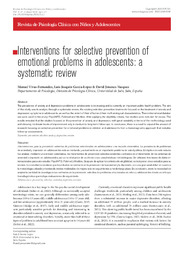Por favor, use este identificador para citar o enlazar este ítem:
https://hdl.handle.net/11000/32069Registro completo de metadatos
| Campo DC | Valor | Lengua/Idioma |
|---|---|---|
| dc.contributor.author | Vivas-Fernandez, Manuel | - |
| dc.contributor.author | Garcia-Lopez, Luis-Joaquin | - |
| dc.contributor.author | Jimenez-Vazquez, David | - |
| dc.contributor.other | Departamentos de la UMH::Psicología de la Salud | es_ES |
| dc.date.accessioned | 2024-05-08T12:16:31Z | - |
| dc.date.available | 2024-05-08T12:16:31Z | - |
| dc.date.created | 2024-05 | - |
| dc.identifier.citation | Revista de Psicología Clínica con Niños y Adolescentes (RPCNA) Vol. 11, Nº 2 (Mayo 2024) | es_ES |
| dc.identifier.issn | 2340-8340 | - |
| dc.identifier.uri | https://hdl.handle.net/11000/32069 | - |
| dc.description.abstract | The prevalence of anxiety and depression problems in adolescents is increasing and is currently an important public health problem. The aim of this study was to analyze, through a systematic review, the existing selective prevention treatments focused on the treatment of anxiety and depression symptoms in adolescents, as well as the extent of their effect and their methodological characteristics. Three international databases were used in this study: PsycINFO, Pubmed and Medline. After applying the eligibility criteria, five studies were included for review. The results revealed that the studies focused on the prevention of anxiety and depression, with great variability in terms of the methodology used and showing moderate levels of improvement only in medium to long term follow-ups. In conclusion, there is a need to expand the amount of research focusing on selective prevention for emotional problems in children and adolescents from a transdiagnostic approach that includes follow-up assessments. | es_ES |
| dc.description.abstract | Intervenciones para la prevención selectiva de problemas emocionales en adolescentes: una revisión sistemática. La prevalencia de problemas de ansiedad y depresión en adolescentes está aumentando y actualmente es un importante problema de salud pública. El objetivo de este estudio fue analizar, mediante una revisión sistemática, los tratamientos de prevención selectiva existentes centrados en el tratamiento de los síntomas de ansiedad y depresión en adolescentes, así como el alcance de su efecto y sus características metodológicas. Se utilizaron tres bases de datos internacionales para este estudio: PsycINFO, Pubmed y Medline. Después de aplicar los criterios de elegibilidad, se incluyeron cinco estudios para su revisión. Los resultados revelaron que los estudios se centraron en la prevención de la ansiedad y la depresión, con una gran variabilidad en cuanto a la metodología utilizada y mostrando niveles moderados de mejora solo en seguimientos a medio-largo plazo. En conclusión, existe la necesidad de ampliar la cantidad de investigaciones centradas en la prevención selectiva de problemas emocionales en niños y adolescentes desde un enfoque transdiagnóstico que incluya evaluaciones de seguimiento. | es_ES |
| dc.format | application/pdf | es_ES |
| dc.format.extent | 12 | es_ES |
| dc.language.iso | eng | es_ES |
| dc.publisher | Universidad Miguel Hernández de Elche | es_ES |
| dc.rights | info:eu-repo/semantics/openAccess | es_ES |
| dc.rights | Attribution-NonCommercial-NoDerivatives 4.0 Internacional | * |
| dc.rights.uri | http://creativecommons.org/licenses/by-nc-nd/4.0/ | * |
| dc.subject | prevention | es_ES |
| dc.subject | selective | es_ES |
| dc.subject | anxiety | es_ES |
| dc.subject | depression | es_ES |
| dc.subject | review | es_ES |
| dc.subject | prevención | es_ES |
| dc.subject | selectiva | es_ES |
| dc.subject | ansiedad | es_ES |
| dc.subject | depresión | es_ES |
| dc.subject | revisión | es_ES |
| dc.subject.other | CDU::1 - Filosofía y psicología::159.9 - Psicología | es_ES |
| dc.title | Interventions for selective prevention of emotional problems in adolescents: a systematic review | es_ES |
| dc.type | info:eu-repo/semantics/article | es_ES |
| dc.relation.publisherversion | https://doi.org/10.21134/rpcna.2024.11.2.1 | es_ES |

Ver/Abrir:
23_43.1_0.pdf
221,49 kB
Adobe PDF
Compartir:
 La licencia se describe como: Atribución-NonComercial-NoDerivada 4.0 Internacional.
La licencia se describe como: Atribución-NonComercial-NoDerivada 4.0 Internacional.
.png)